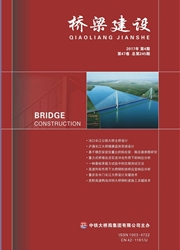

 中文摘要:
中文摘要:
为准确把握拉索的动力学规律并指导工程应用,以拉索非线性振动理论(拉索自振频率的摄动法公式)为基础,以工程中常用的典型拉索为例,对拉索非线性自振频率的边界条件效应、参数敏感性以及区间估计方法进行研究。研究结果表明:拉索的边界条件效应随拉索长度、索力以及频率阶次的不同而不同;索力、线密度、弦长、抗弯刚度4个参数对于拉索各阶自振频率在影响程度、影响方式方面均存在显著差异,总体而言,自振频率偏差与索力和抗弯刚度2个参数的偏差成正比,与线密度和弦长2个参数的偏差成反比;根据拉索参数的概率统计特征能够获得拉索自振频率的区间估计。
 英文摘要:
英文摘要:
To have an exact understanding of the dynamic law of stay cables and to guide the practical engineering application, the boundary condition effect, parameter sensitivity and interval estimation methods of nonlinear natural vibration frequencies of the stay cables were studied on the basis of the nonlinear vibration theory of the cables (perturbation method formulas for the natural vibration frequencies) and by way of examples of the typical stay cables commonly used in the practical engineering. The results of the study demonstrate that the boundary condition effect differs with the different length, tension and frequency orders of the cables. The degrees and ways of influence of the 4 parameters like the cable tension, linear density, chord length and bending rigidity on various orders of the natural vibration frequencies have distinctive differences. Generally, the differences of the natural vibration frequencies are directly proportional to those of the two parameters of the cable tension and bending rigidity and are reversely proportional to those of the two parameters of the linear density and chord length. From the probability statistic characteristics of the stay cable parameters, the interval estimation of the natural vibration frequencies of the cables can be acquired.
 同期刊论文项目
同期刊论文项目
 同项目期刊论文
同项目期刊论文
 期刊信息
期刊信息
